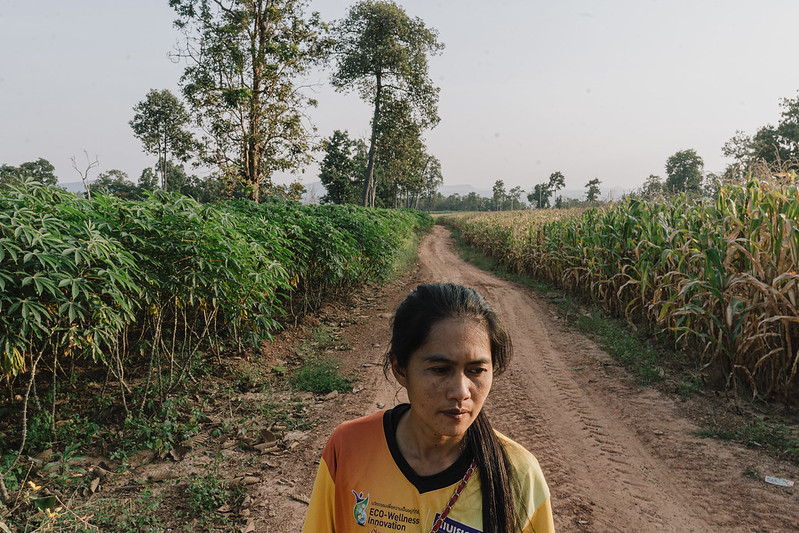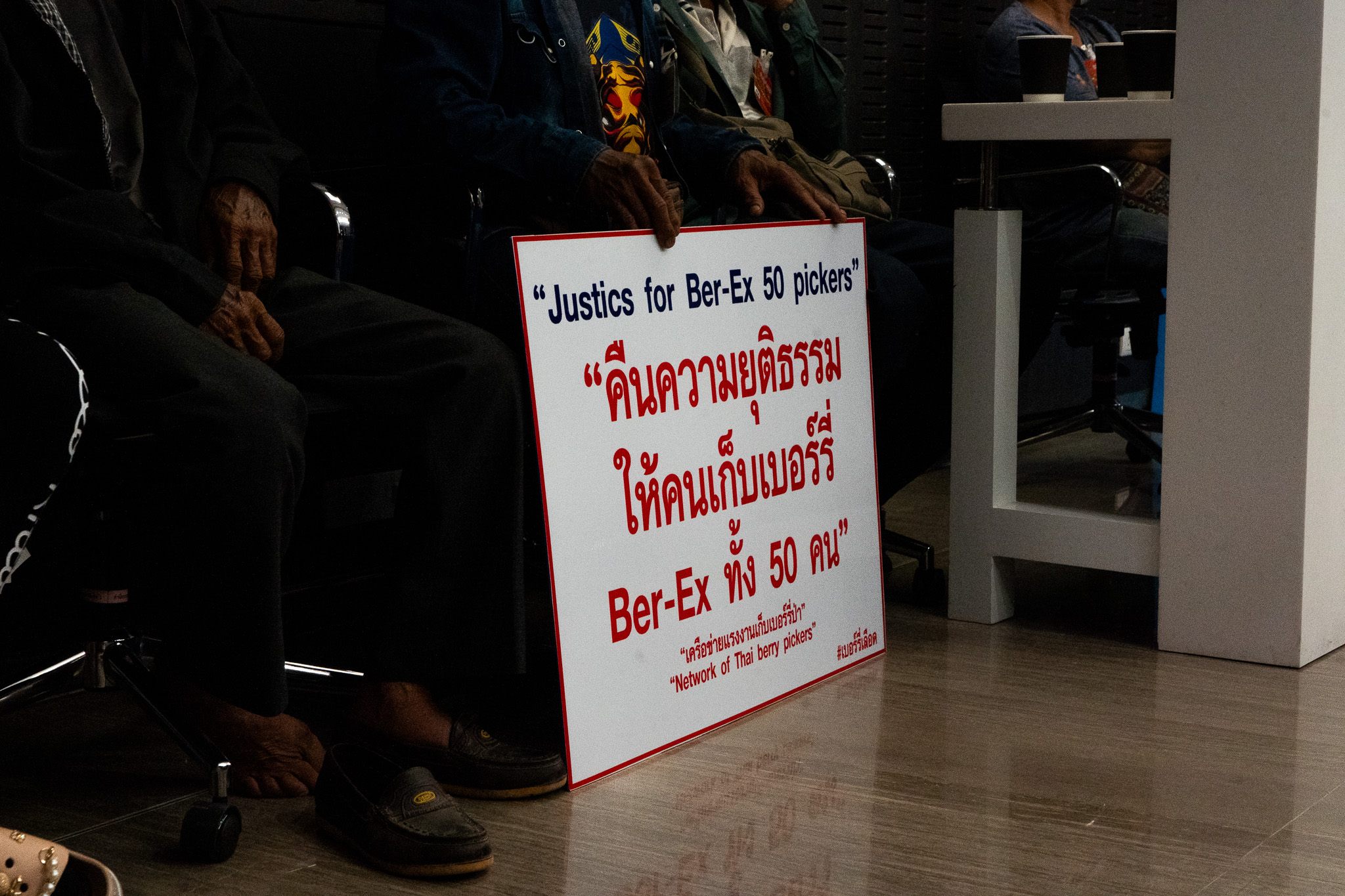Thailand’s economic downturn is often discussed in terms of GDP, national markets, and investment statistics, but behind the numbers, individuals employed in the country’s enormous informal economy are feeling deep financial strain. At the Aorjira market in Khon Kaen, vendors struggle to turn enough profit to support themselves and keep their small businesses afloat.
GUEST CONTRIBUTION by Mariko Powers and Zoe Swartz
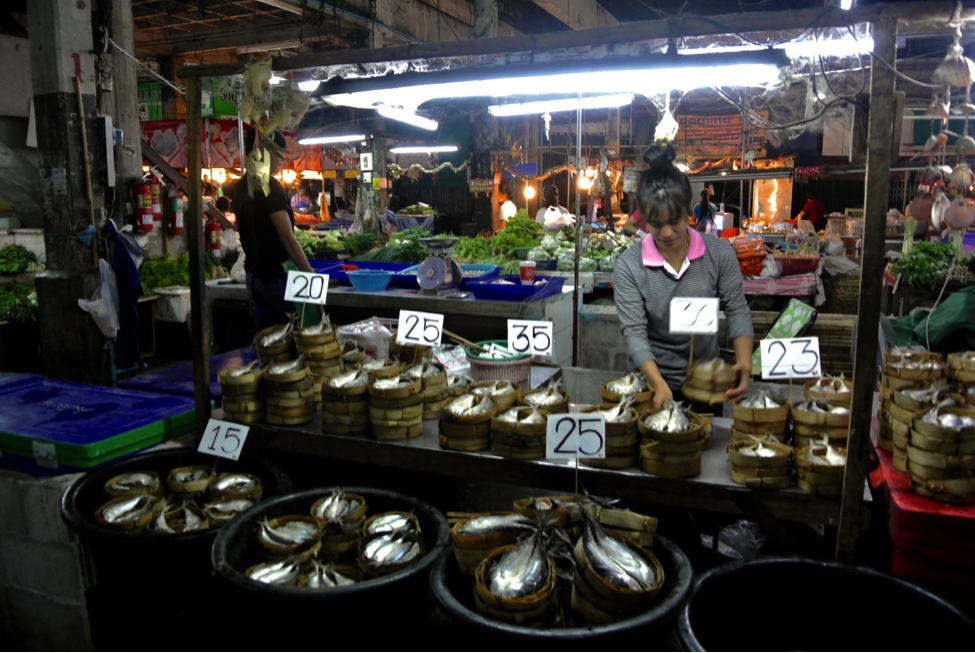
The Aorjira Market has been a mainstay for Khon Kaen shoppers for decades. But now, vendors at the market say that customers have significantly curbed their spending in the past year.
Fluorescent lights flicker as customers weave through the narrow alleys and islands created by stalls at the Aorjira market, the largest food market in Khon Kaen. Vendors showcase everything from silver fish to hanging red meats, robust leafy vegetables, vibrant fruits, and countless bags of rice. The bustling traffic and diversity of products suggest that the market is thriving, but vendors behind the stalls face deep financial uncertainty.
“It’s difficult to sell rice because customers buy less,” says Ms. Nawarat Tapbun, a 72-year-old native of Khon Kaen, who has been selling rice at this market for fifty years. “The whole economic system is suffering now,” she says, shaking her head. Since last year’s coup, she has been struggling to turn the profits she had known in previous years. What she used to be able to sell in one day now takes her two.
Ms. Narawat is not alone. The vast majority of Thailand’s workforce – over 64% in 2013 – make their living in the informal sector. These self-employed workers, including vendors, tuk-tuk drivers, and farmers, are more vulnerable to economic fluctuations because they often lack social protection – and they are feeling the brunt of the recent economic downturn in the Northeast.
Ms. Aumpai Koetphon, 64, who owns a shoe and accessories shop at Khon Kaen’s downtown bus terminal, has been struggling to keep her business open, as well.
“I have to think about how to pay the rent and people aren’t buying much from my store,” she says, citing politics as the source of the poor economy in Thailand. “It’s been getting worse and worse. The government keeps promising a better economy, but nothing has happened,” she says.
In interviews with dozens of market vendors in Khon Kaen, salespeople report that their daily income has decreased as much as 50% since the coup last year. Paul Collier, an economics professor at Oxford University, has estimated that, in general, coups cost a country 7% of a year’s income when tracked over time.
While it is difficult to translate the junta’s rule directly to reduced incomes, Ms. Panee Srikaew, 47, who makes her living selling lottery tickets outside the market, can link her losses to current government policy. A new policy standardizing the price of lottery tickets at 80 baht diminished vendor’s profits to 4 baht per ticket. Ms. Panee used to make 500 baht per day in sales, and now has an income of 200 baht a day.
Mr. Titipol Phakdeewanich, a political science lecturer at Ubon Ratchathani University, says that the current situation is more complicated than the military government’s economic strategy. Falling exports, declining property values, and the performance of global markets have buffeted the country independent of the current regime.
“It’s not just the coup that made the situation worse,” he says. “We’ve never had a good plan for economic growth. Successive governments haven’t done a good job of promoting the Thai economy – they blame the previous government and never learn from each other. We see now that everything is based on political expedience.”
This lack of strong economic planning came at a cost, which is now reverberating in Khon Kaen’s informal sector. Ms. Nawarat leads a simple life by the train tracks in one of the city’s slum communities. Her already frugal lifestyle has not changed much since the coup, however, she feels that her financial situation is deteriorating.
For 50 years, she has been selling sticky rice at the market every day from 3 a.m. until 9:30 a.m. and managed to set aside about 200-300,000 baht in savings. But this roughly equals the debt she racked up from investment losses and loans she received to start her and her children’s rice business.
Ms. Narawat is proud to have successfully chipped away at her family’s debt – once almost a million baht – but she still fears she will not be able to support herself and her husband through their old age. At 72-years-old, Ms. Nawarat plans to work until she is no longer able, but she knows that those days are coming to an end. “I’m worried my savings will run out before I die,” she says.
Hers is a familiar story in the debt-ridden Northeast. In recent years, Thailand’s household debt spiraled to a level “among the highest in the region and well above average for a country in the upper-middle income range,” a 2014 Bank of Thailand report finds.
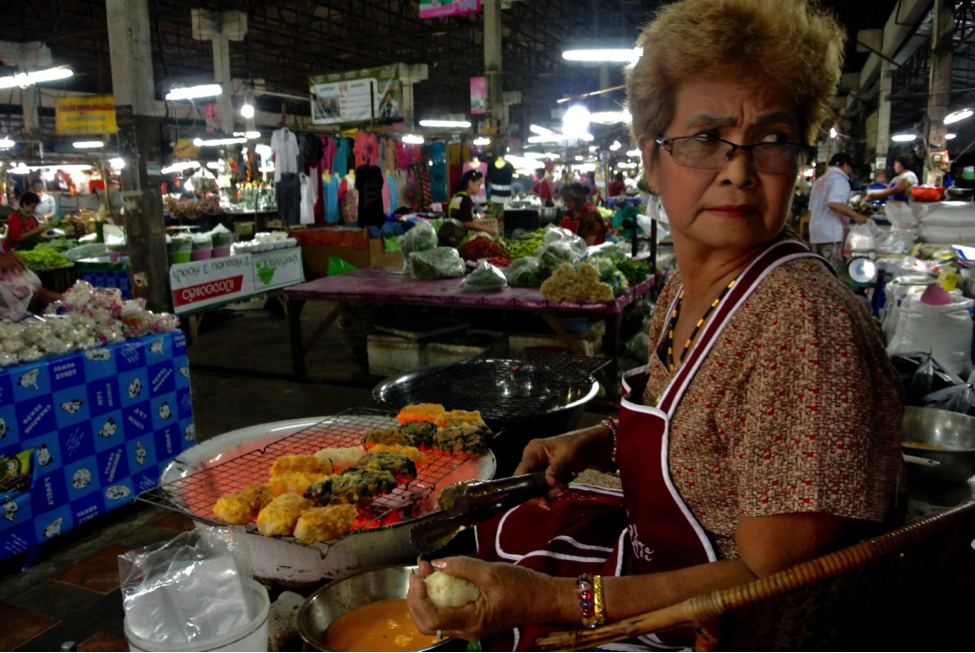
Household incomes in Isaan are the lowest in Thailand, so additional losses in earnings carry a significant impact. Pictured above: Ms. Narawat Tapbun, 72.
Ms. Nawarat used to be confident that she could turn a profit on any purchase she made. She earned money, for example, by buying a fish for 100 baht, grilling it over her charcoal stove, and selling it for 140 baht. Now, she counts every penny twice before making a purchase and tends to stick only to her staples that she knows will sell well.
Currently, Thailand is the slowest growing economy in Southeast Asia and has been stagnating in and on the verge of recession for several years. The country’s economic outlook has continued to fall since the 2014 coup, with Thailand’s finance ministry cutting its economic growth forecast from 5% down to 2.7%.
Many vendors in the market now resort to depleting their savings, leaving nothing to fall back upon. Ms. Aumpai has already closed one of her shops and is using her dwindling savings to keep her shoe store afloat. “If this one doesn’t get better by the end of the year, I will close this one too,” she says, gesturing to the rows of sneakers, sandals, and flats lining the walls. “I don’t have a plan for what I will do if this one fails.”
Those affected by the hurting economy are adapting to a reduced income by curbing their own spending. Ms. Aumpai says that she stopped eating out as much as she used to and is cutting any unnecessary expenses. As the customer base of the small merchants at the Aorjira market is made up of mainly self-employed people, their reduced spending perpetuates a cycle of reduced sales.
In September, Thailand’s consumer confidence fell to a 16-month low and showed only slight improvement in October, according to a survey by the University of the Thai Chamber of Commerce (UTCC). Ms. Aumpai says she wants “the government to make the economy better” but has little faith that this will come to pass.
In August, Prime Minister Prayuth Chan-ocha reinstated Mr. Somkid Jatusripitak, who steered the economic ship of the Thaksin government, as minister of finance and deputy prime minister. The junta’s decision to install Somkid suggests an uncertain economic vision, which both rejects and relies on the very policies that the military government once condemned as heedless populism.
After adding Mr. Somkid Jatusripitak to its economic team, the military government approved a 136 billion baht (about $3.8 billion) stimulus package including the revival of the village fund program, once one of the Thaksin government’s key stimulus programs.
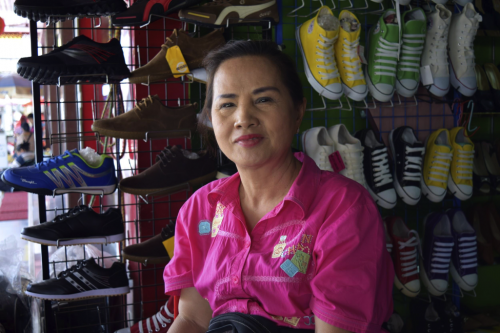
Ms. Aumpai continues to run her businesses for now, but sees financial ruin on the horizon.
As Southeast Asia’s second-largest economy, Thailand’s position as a hub of tourism and manufacturing helped clench its status as an upper middle-income country. However, with incomes falling, consumer spending stagnating, and household debt on the rise, Thailand’s long-established veneer of stability is wearing away.
Dr. Titipol says that, in general, Thailand struggles to become a fully industrialized economy because investment in the country still relies on cheap unskilled labor – which is rapidly becoming less expensive in neighboring states. As a result, Thailand is losing its competitive edge. Dr. Titipol asserts that Thailand needs to take labor reform “more seriously.”
“We still have other strengths that Laos, Vietnam, and Myanmar don’t have, like infrastructure,” Dr. Titipol explains, “we should be able to use this to support the economy and produce labor that will fill the market.”
Despite this dismal economic situation, life continues as usual at the market. Vendors still arrive at 3 a.m. to set up their booths and donate alms into the shining bowls of young monks in their rust-orange robes. Although Ms. Narawat concedes that conditions are not ideal, she has no intention of leaving her stall. “It’s not about happiness,” she states seriously, “it’s about making a living.”


